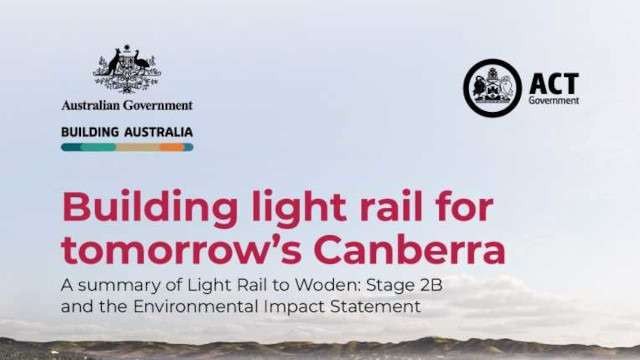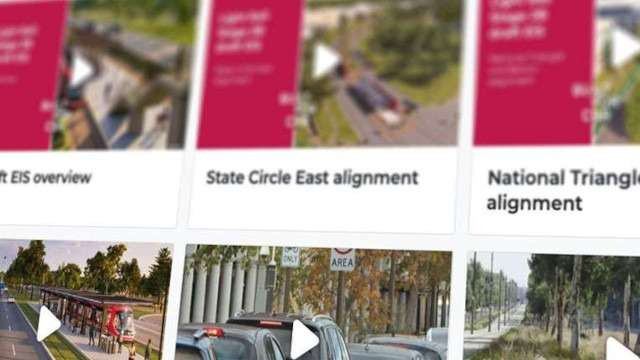Stage 2B Draft Environmental Impact Statement
Public exhibition now complete
In 2025, Infrastructure Canberra submitted a draft Environmental Impact Statement (EIS) to both the Australian and ACT governments for approval. The draft EIS was on public exhibition for 45 business days between 7 July 2025 and 5 September 2025.
Infrastructure Canberra is considering all submissions and will publish a submissions report alongside the revised, final EIS.
About the Stage 2B EIS
Infrastructure Canberra has submitted a draft Environmental Impact Statement (EIS) to both the Australian and ACT governments for approval.
The draft EIS examines the project's potential environmental, social and economic impacts, and suggests ways to manage or mitigate them. It includes the ACT Government's preferred alignment option, State Circle East, and an alternative alignment option through the National Triangle and Barton.
The draft EIS is on public exhibition for feedback in a submission or representation.
An EIS assesses the environmental, social and economic impacts a project may have on its surroundings and suggests ways to manage them. An EIS:
describes the current environment of the project area
details the features of the project and describes how it would be built and operated
looks at the anticipated impacts of the project
outlines how positive outcomes may be achieved or enhanced
outlines how potentially adverse impacts can be avoided or reduced
provides a conclusion about whether the impacts are acceptable and justified.
Stage 2B is a complex project that requires several Australian and Territory government environmental and planning approvals.
The project connects Commonwealth Park to Woden, passing over areas of Commonwealth and Territory land, and is likely to significantly impact matters of national environmental significance.
The Australian Government Department of Climate Change, Energy, the Environment and Water (DCCEEW) is responsible for protecting nationally significant matters using the Environment Protection and Biodiversity Conservation Act 1999 (EPBC Act). The EPBC Act protects and manages nationally significant plants, animals, habitats and heritage places.
The Territory Planning Authority (TPA) requires formal assessment of potential environmental impacts in zoned Territory Land for some proposals. This is done through an EIS process, as outlined in the Planning Act 2023.
The draft EIS has been prepared to satisfy legislative requirements under both the EPBC Act and the Planning Act.
DCCEEW will consider the consistency of the draft EIS with the Commonwealth EIS guidelines (July 2024). The TPA will consider the consistency of the draft EIS with the EIS scoping document it issued for the project in March 2024.
The draft EIS was on public exhibition for 45 business days between 7 July 2025 and 5 September 2025.
Under the EPBC Act, Infrastructure Canberra has published the draft EIS. You can view the draft EIS on this webpage.
Under the Planning Act, the draft EIS is displayed on the TPA’s website.
Submissions on the draft EIS closed on Friday, 5 September 2025.
The draft EIS was on public exhibition for 45 business days between 7 July 2025 and 5 September 2025.
All submissions and representations will be considered by both DCCEEW and the TPA.
Feedback from the community will be used to inform revisions to the draft EIS, where appropriate.
The revised, final EIS will include a report outlining the comments received, issues raised and a response to the issues and values identified. It will include one alignment.
The final EIS will be made publicly available, and Infrastructure Canberra will notify those who made submissions. At the time of your submission, you were provided with a submission ID which can be used to find the response to your submission in the submission report.
The final EIS will be lodged again to DCCEEW and TPA for consideration and approval. This process will determine if the project can proceed and if so, under what conditions.
Following completion of the EIS process, the Project will progress to Development Application approval, Parliamentary approval and Works Approval.
Infrastructure Canberra undertook extensive community consultation during the public exhibition period from 7 July 2025 to 5 September 2025.
This included 11 drop-in information sessions and a community forum. These events were held along the proposed alignment and provided community members with an opportunity to ask subject matter experts about the draft EIS.
Full printed copies of the draft EIS were available to view at:
Civic Library (Civic Square, London Circuit, Canberra City)
Dickson Library (Antill Street, Dickson)
Gungahlin Library (Corner of Hibberson and Gozzard Streets, Gungahlin)
Tuggeranong Library (Cowlishaw St, Greenway)
Woden Library (Corinna Street, Phillip)
Draft EIS documents
The draft EIS examines the environmental, social and economic impacts Stage 2B may have on its surroundings and suggests ways to manage them.
The draft EIS is structured in a way that makes it easier for the community to understand the impacts in areas most important to them. The document looks at the project as a whole and as seven unique precincts, plus the Mitchell Depot (which would be expanded by the project). Precincts include Commonwealth Avenue, Parliament House, Inner South, Yarra Glen and Woden. The draft EIS also includes an alternative alignment through National Triangle and Barton precincts.
View the parts and chapters of the draft EIS in the sections below.
Part A describes the project and discusses the surrounding context. The executive summary and first five chapters provide an overview of the project and draft EIS. The remaining chapters in Part A consider construction, sustainability, legislation and EIS assessment approaches and methodologies.
Use the button below to download all of Part A as a single PDF, or choose a tile below to read individual chapters in an accessible format.
Part B is the assessment of the environmental impacts resulting from the project’s construction and operation. These 10 chapters provide an assessment for each precinct, Mitchell Depot and issues that are not precinct-specific and/or apply to the whole project.
Use the button below to download all of Part B as a single PDF, or choose a tile below to read individual chapters in an accessible format.
Part C includes a chapter that lists management and mitigation measures to address the identified environmental impacts. The final chapter concludes and summarises the draft EIS findings and details the justification for carrying out the project.
Use the button below to download all of Part C as a single PDF, or choose a tile below to read individual chapters in an accessible format.
Part D includes appendices and technical reports that support the draft EIS.



